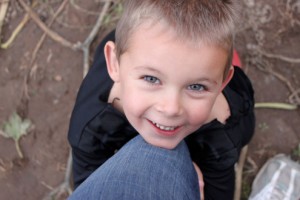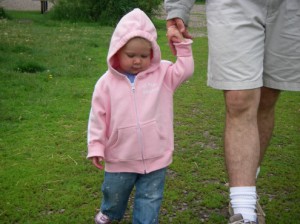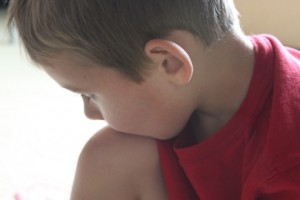 In my parenting, the goal of obedience doesn’t exist. It’s important to emphasize the part about it being a goal. Notice that I didn’t say, “Obedience doesn’t exist in our household.” I mean that our children’s obedience to my husband and me is not something we specifically aim for.
In my parenting, the goal of obedience doesn’t exist. It’s important to emphasize the part about it being a goal. Notice that I didn’t say, “Obedience doesn’t exist in our household.” I mean that our children’s obedience to my husband and me is not something we specifically aim for.
I get its importance, though, and I understand why parents expect it. It’s nice! And sometimes necessary. We tell our kids to do things because we want them to be safe and healthy. Most directions are not urgent: It’s time to get your shoes on. Please clear your plate. Go throw your garbage away. Though some directions are: STOP! (running in the street). Since we give a multitude of necessary directions every day, compliance is certainly a nice perk, not to mention needed.
But it’s also important to keep in mind that kids under age 7 are going through crucial periods of development of their autonomy and will…certainly the toughest years for expecting obedience. This is not to say I don’t have any expectations of my kids. I do.
- I expect them to have feelings. My wishes may or may not line up with their objectives, and they will have feelings about that.
- I expect them to express their feelings; to feel free to communicate with me at a level that is appropriate for their development.
- I expect them to help take care of themselves.
- I expect them to contribute to the family and household.
- I expect them to be autonomous; to do things for themselves.
- I expect them to take initiative; to have their own ideas and want to see them through.
- I expect them to not like everything that needs to be done. I don’t. No one does.
 When I shift my perspective on behavior and aim for an understanding, attached relationship rather than simple obedience, my children are naturally inclined to follow my directions. We have the kind of relationship in which, when I say, “STOP!” or “NO!” in a dangerous situation, they stop immediately. They’re not behaving out of conditioned obedience or because I have actively taught them to obey as one of my goals of raising them. They listen to me because of the status of our relationship. Our connection, combined with the notes of urgency and fear in my voice, creates a crystal clear distinction between this kind of communication and all of our regular daily interactions. There is no need for spankings, isolating time-outs, punishments, or shameful exclamations of “How could you do that?” and, “Just go to your room and stay there!” It’s because of the connected relationship I have with my kids that when I say “No” with authority, I don’t have to say anything else.
When I shift my perspective on behavior and aim for an understanding, attached relationship rather than simple obedience, my children are naturally inclined to follow my directions. We have the kind of relationship in which, when I say, “STOP!” or “NO!” in a dangerous situation, they stop immediately. They’re not behaving out of conditioned obedience or because I have actively taught them to obey as one of my goals of raising them. They listen to me because of the status of our relationship. Our connection, combined with the notes of urgency and fear in my voice, creates a crystal clear distinction between this kind of communication and all of our regular daily interactions. There is no need for spankings, isolating time-outs, punishments, or shameful exclamations of “How could you do that?” and, “Just go to your room and stay there!” It’s because of the connected relationship I have with my kids that when I say “No” with authority, I don’t have to say anything else.
So, although my husband and I don’t expect obedience from our kids, we get it. Why? Why does it happen so naturally and willingly?
- Because we recognize our kids’ objectives. We know that, as kids, they have other ideas and different priorities than we parents do.
- Because we value their feelings. And we prove it by listening and accepting them on a daily basis.
- Because we communicate with respect and empathy.
- Because we aim for understanding…their feelings, their goals, their interests & disinterests. We make it a priority to know what makes our kids tick.
- Because we value their uniqueness. The way they’re not like any other kids.
- Because we aim to be aware of their levels of physical, cognitive, and emotional development.
 All of this leads to a close, secure, attached relationship. My husband and I replace a goal of obedience with one of connection and trust instead. Because if there is connection and trust in a parent-child relationship, guess what comes naturally? Obedience. Children are drawn to “do right by” those to whom they are emotionally connected.
All of this leads to a close, secure, attached relationship. My husband and I replace a goal of obedience with one of connection and trust instead. Because if there is connection and trust in a parent-child relationship, guess what comes naturally? Obedience. Children are drawn to “do right by” those to whom they are emotionally connected.
Do our kids ever “disobey?” Of course. But we don’t see it like that. We see all of these moments in which they’re “not listening” with an understanding of who our children are and what they need. It’s not personal, it’s developmental. I find that if I shift my perspective from You need to do what I say! to one of How can we solve this problem to meet everyone’s needs?, my directions do get carried out. I see ‘not listening’ as…
- a child having strong, very acceptable, very human feelings. Children need validation and acceptance.
- immature brain development. Children need time to develop brain connections necessary for self control and self-discipline.
- an example of a child exerting autonomy and initiative. This is very developmentally appropriate; children need to be autonomous.
- a show of distance in our relationship. Children need to feel a sense of significance and belonging.
Meet the needs, get the cooperation.
Instead of expecting obedience from my children, I have shifted my thinking to expect developmentally appropriate behavior. I understand my kids’ social, emotional, and cognitive capabilities, and I work on cultivating a relationship based on that understanding. By parenting not strictly for obedience, but for a combination of a connected relationship and authority, kids give their willing cooperation by default.





